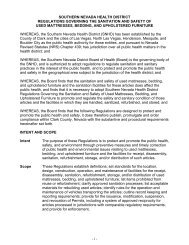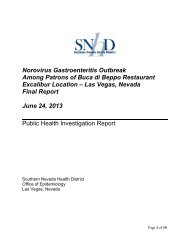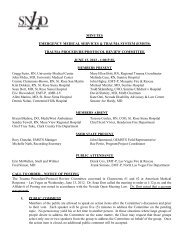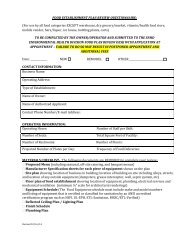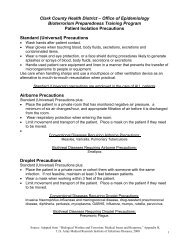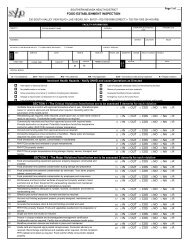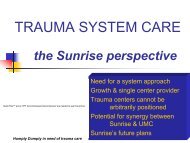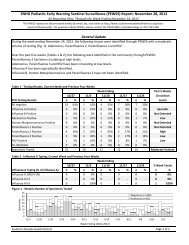Current Trauma Status Report - Southern Nevada Health District
Current Trauma Status Report - Southern Nevada Health District
Current Trauma Status Report - Southern Nevada Health District
Create successful ePaper yourself
Turn your PDF publications into a flip-book with our unique Google optimized e-Paper software.
<strong>Trauma</strong> Center Funding Comparison Study<br />
Introduction<br />
Providing a stable source of funding for trauma centers has been an ongoing issue since the early<br />
development of trauma systems in the country. Changes in funding sources, particularly insurance<br />
payers, have created instability over the years. 18,19,20 Improving revenue cycle management and payer<br />
contracting has helped, but in some communities these efforts have not been substantial enough to<br />
stabilize their trauma system.<br />
Below, The Abaris Group provides an overview of identified funding sources for trauma care.<br />
State Funding Sources<br />
Many states provide funding for the administration of their state’s trauma system at the state level.<br />
However, there are only four states that provide ongoing funding to support their trauma centers:<br />
Illinois, Mississippi, Oklahoma, and Washington. California had a one-time funding program that<br />
expired in 2003.<br />
Arizona<br />
During November 2002 the state voted to approve doubling the state’s tobacco tax on cigarettes to<br />
$1.18 a pack and use the $150 million strictly for the trauma centers. The measure passed two to one.<br />
California<br />
During the 2001 legislative session, the California Legislature passed AB1430, The <strong>Trauma</strong> Fund Act,<br />
which encouraged the development of a statewide network of trauma centers and established a one<br />
time source of funds for trauma centers in the state. The $20 million allocated from this bill was<br />
renewed during 2002 and provided support to the trauma centers through 2003. The funding was<br />
allocated on a fixed and volume basis. Each trauma center received a fixed amount according to their<br />
designation level (e.g. $150,000) and then an allocation based on volume of patients as determined by<br />
trauma registry entries.<br />
Illinois<br />
The State of Illinois established a fund for uncompensated trauma care in 1993. The funding comes<br />
from a $5 fee placed on every moving violation over $55. In 1994 a $30 fine from each DUI conviction<br />
or order of suspension was added. Since 1993, they have expended approximately $20.4 million. The<br />
amount of funding each hospital receives depends on the number of trauma patients treated.<br />
Additionally, funding is provided to those hospitals that care for Medicaid trauma patients. There is no<br />
funding for physicians.<br />
Mississippi<br />
In 1998 the State of Mississippi began allocating between $8.0 – 8.5 million annually for<br />
uncompensated trauma care. The funds come from revenue generated by Mississippi’s Tobacco<br />
Settlement principal ($6.0 million) and from moving traffic violations ($2.5 million). There are seven<br />
18 <strong>Trauma</strong> Care: Saving Lives Despite Setbacks, Zoller, M. Medical World News, June 1988.<br />
19 <strong>Trauma</strong> Collapse, Can the system be saved, Williams, MJ. California Hospitals, October 1999.<br />
20 <strong>Trauma</strong> Care: “Lifesaving System Threatened by Unreimbursed Costs and Other Factors”, GAO, May 1991.<br />
Page 78



